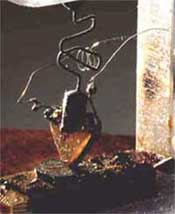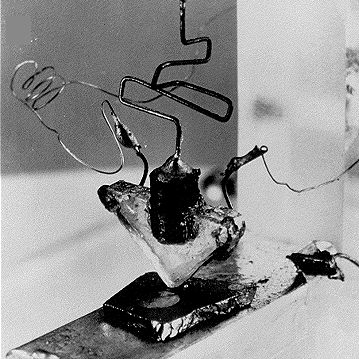In honor of the 60th birthday of the transistor, here are some photos:
The first transistor was developed in 1947 at Bell Labs by Shockley, Brattain, and Bardeen and it was made from germanium not silicon. Germanium was used through the 50's and into the 60's before being completely replaced by silicon transistors. Those of you who are old enough will remember the first transistor radios in the 50's. I do. Before long there was a competition over the number of transistors in the radio. Seven transistor radios, nine transistor radios--a big advertising deal was made over the number of transistors and the consumer was led to believe that more is better. Around the time I got into electronics, around 1959, 1960, I disassembled a 14 transistor radio and discovered that several of the transistors were fake! (had only two leads, or had the leads twisted together) A good radio can be built with six to nine transistors but they added several fake ones to boost the count and fool the public into thinking it was a better radio. This was a interesting lesson.
Throughout the 50's and into the 60's, transistors were made and packaged one at a time, and then assembled into circuits that you could see without your glasses and work on with your hands and a soldering iron. Plenty of transistors are still used as individual devices today, especially in high-power or radio circuits, but in 1959 Jack Kilby at Texas Instruments patented the first integrated circuit, where more than one transistor was fabricated simultaneously on the same substrate, along with components like resistors and capacitors to form a complete circuit that performed a function. The photolithography techniques used to "print" these circuits soon made it just as easy to make a miniature 20 transistor circuit as it was to make a single transistor and this was the way to the future. In 1971, Intel introduced the first microprocessor, a slow little 4-bit micro containing about 2,500 transistors. By 1975, Popular Electronics published the famous article that launched the personal computer revolution. It was an article on how to build a computer using Intel's 8080 microprocessor. The 8080 contained about 4,000 transistors. Today the micro in your average personal computer contains about 500 million transistors. The latest dual-core server processors contain about 800 million. Your typical desktop or laptop computer today contains over 2 billion transistors in all. The simple transistor has come a long way.



1 comment:
Post a Comment